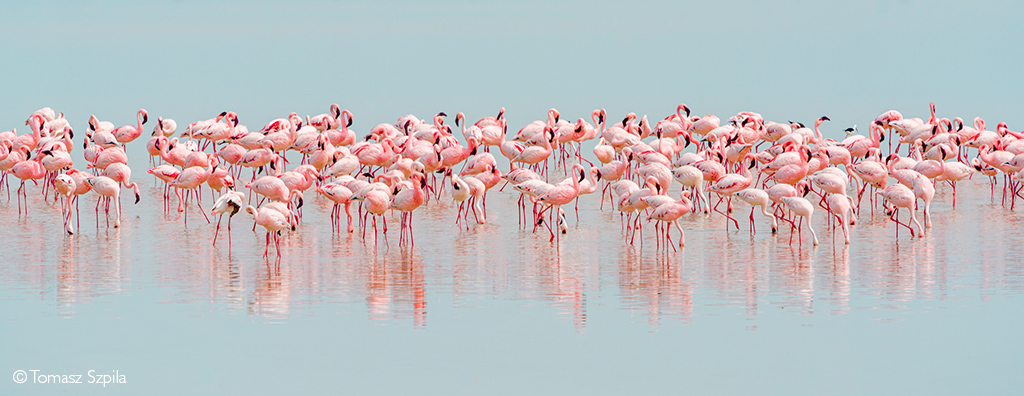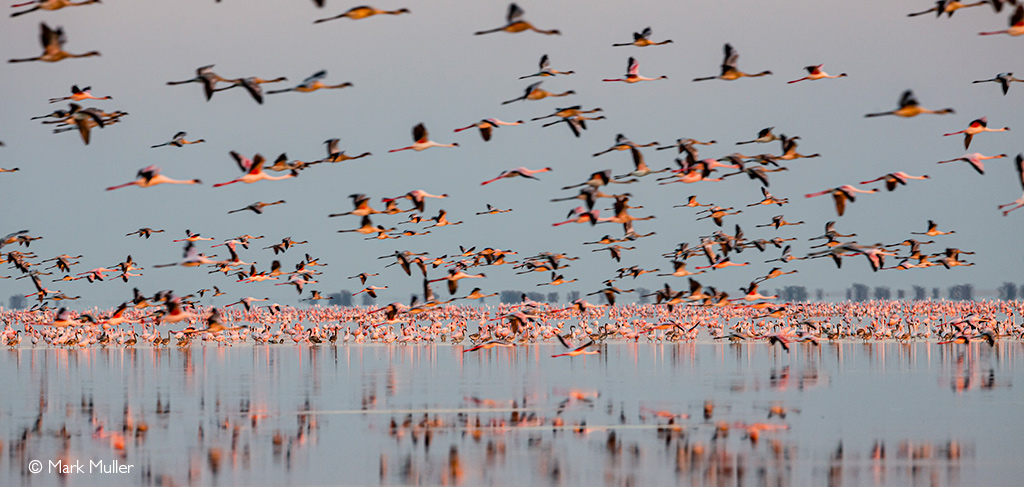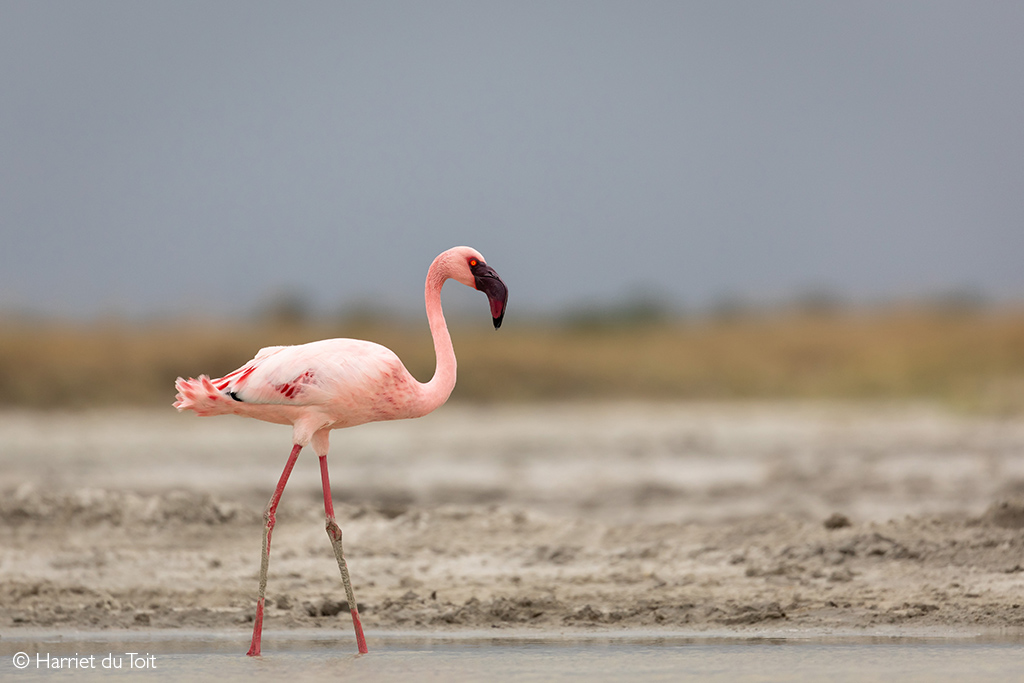
In 2019, over half a million flamingos were counted in Botswana’s Sua Pan. This is a remarkable increase from the last recorded count in 2009. This new tally, made possible by innovative use of aerial photography and machine learning, underscores the critical role of Sua Pan as a habitat for both greater and lesser flamingos. But the findings also highlight the need for better conservation efforts, particularly around maintaining adequate water supplies, as climate change poses a growing threat to these vital ecosystems. Christy Bragg explains.
Over 500,000 flamingos were gathered in the Sua Pan, the eastern pan in the Makgadikgadi Pans in Botswana, in 2019. How do we know this, since there has not been a published count of flamingos from the pan in the last decade, and the last count (in 2009) registered only 163,434? In June 2019, civilian scientist Mike Holding mounted a camera on his Cessna plane, jumped in and then flew transects systematically across the pan, capturing over 3700 photographs of little pink dots (which is what flamingos look like from 600m high up in the sky).
So, who was the poor soul who poured over the 3715 photographs and counted all the tiny pink dots? The counting was not done by some unfortunate postgrad trying to earn extra beer money. It was done by machine learning. According to a team of researchers from the University of NSW Sydney’s Centre for Ecosystem Science, machine learning was an accurate and far quicker way to count the dots. They found that machine learning was just as good as doing it manually, and confirmed this by comparing a small sample of photographs one of the researchers counted to the machine-learning counts. The results differed by only 1.4%.


The significance of the Sua Pan
The high numbers of feeding flamingos highlight the importance of Sua Pan as a critical feeding site for flamingos in southern Africa, for both greater flamingos and lesser flamingos (listed as Near Threatened by the IUCN). The Makgadikgadi Pans also rank in the top ten largest breeding sites in Africa, Europe and Asia for flamingos and form one of only five sites worldwide where lesser flamingos regularly breed. It also likely supports the largest breeding population of greater flamingos in Africa. In 1975, there were an estimated 1.7 million flamingos in these pans, so there is some concern about a decline in the population. We simply don’t know enough about flamingo population numbers. We need transparent and rigorous methods for estimating populations, and these need to be repeated regularly to detect trends.
 Want to go on a Botswana Salt Pans Expedition? Or ask our travel experts to plan the perfect African safari for you by clicking here.
Want to go on a Botswana Salt Pans Expedition? Or ask our travel experts to plan the perfect African safari for you by clicking here.
The findings highlight that the Makgadikgadi system is of international significance for flamingos, which means that this system needs to be adequately protected. The area has some formal conservation status – the Makgadikgadi Pans are an Important Bird Area (IBA), and 44.7% of the area is protected as a wildlife management area. There is also a Nata Bird Sanctuary, a community-protected reserve at the mouth of the Nata River, and a flamingo sanctuary south of Sua Pan, protecting core breeding habitat. However, the authors point out a missing piece in the conservation puzzle – water.

Conserving flamingos requires more than just a protected area
Flamingos need water. Their feeding and breeding depend heavily on the seasonal flooding of their habitat. Breeding is only triggered with sufficient flooding, and the flamingos rely on the emerging islands of mud and salt for nesting. Therefore, breeding success depends on rivers upstream of their breeding sites being in good condition and not being overutilised. This is something that is frequently overlooked, according to Professor Kingsford from the USNW University. There needs to be a recognition that sustaining river flows is very important and that currently, a lot of decisions around water management are made on an ad hoc basis, not considering the whole catchment. Even though it’s a national park, it takes more than protected area status to make the Makgadikgadi system function – it fundamentally relies on water.
Climate change is another burning concern for the flamingos. The models are not accurate enough to predict how rainfall will change. Higher temperatures might lead to increased evapotranspiration of the pans, reducing their habitat suitability for flamingos. This makes it even more crucial to ensure we buffer water supplies in rivers to help mitigate the looming impacts of this threat. Prof Kingsford even goes so far as to say it is more important to keep a closer focus on the water supply than to keep regular counts of the flamingos.


AI for wildlife monitoring
Australia is already using drones and Artificial Intelligence (AI) to count waterbird colonies. AI is more accurate and saves resources, although it does require the capacity to store and analyse massive data sets. The next stage is to teach AI to detect more cryptic species in the environment. Since there has been such an advancement in AI training (take for example, the ability of AI to identify melanoma cells in skin tissue samples), it should only be a matter of time before it learns to distinguish and count other wildlife species within the background noise of more diverse habitats. Given the high rates of global biodiversity and habitat loss, the better we can understand how species respond to changes in the environment, the more empowered we will be to address these changes.
References
Yang, s., Francis, R.J, Holding, M & Kingsford, R.T, 2024. Aerial photography and machine learning are used to estimate extremely high flamingo numbers on the Makgadikgadi Pans, Botswana. Global Ecology and Conservation, Volume 53: e03011.
To comment on this story: Login (or sign up) to our app here - it's a troll-free safe place 🙂.![]()





